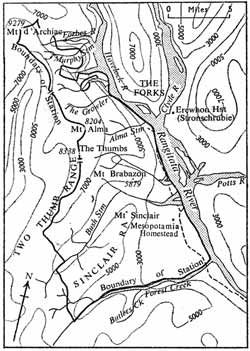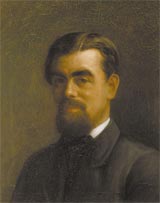Self Portrait 1873 Samuel Butler. Oil on canvas. Collection of Christchurch Art Gallery Te Puna o Waiwhetu, presented by the Canterbury College Board of Governors 1933
Samuel Butler’s 1872 novel Erewhon depicted an imagined civilisation in a ‘forbidden country beyond the mountains’. The landscape for this new utopia was inspired by the Canterbury high country where the English writer lived and worked as a run-holder between 1858 and 1864. Though his title was an anagram for ‘nowhere’, Butler conceived this fictional world as a satirical mirror that would reveal the hypocrisies of Victorian society.
Samuel Butler
Samuel Butler was born in December 1835, at Langar Rectory, Nottinghamshire, England, the second child of the Reverend Thomas Butler and his wife, Fanny Worsley. He studied Classics at St John's College, Cambridge, from 1854 to 1858 and then set off for New Zealand in 1859. He arrived in Lyttelton early in 1860 and proceeded to explore the upper reaches and mountain headwaters of the four major Canterbury rivers, seeking unclaimed sheep country. By October 1860 he had discovered and consolidated a run of 55,000 acres in the upper Rangitata River valley, which he named Mesopotamia.
Butler was undoubtedly one of Canterbury's significant early colonial settlers. He was very involved with many facets of the arts in Christchurch, spending increasingly long periods in the city. He was an active member of the Canterbury Club and the Canterbury Dramatic Society and was an able musician. However, he remained in New Zealand for a relatively short period of time. In June of 1864 he returned to England, settling in London for the remainder of his life. His departure occurred with a suddenness which caused considerable speculation. He later said he regretted the harm this did to his friendships, especially that with William Sefton Moorhouse, the one-time Superintendent of the Canterbury Province.
 The true reason for Butler's sudden departure was never publicly disclosed. On his return to London he studied at Heatherley's School of Art and the Royal Academy School and exhibited at the Royal Academy from 1869 to 1876. However, by 1877 Butler had abandoned his painting in favour of writing. He was a renowned classicist and had already begun writing his celebrated novel Erewhon in 1870. It was published in 1872.
The true reason for Butler's sudden departure was never publicly disclosed. On his return to London he studied at Heatherley's School of Art and the Royal Academy School and exhibited at the Royal Academy from 1869 to 1876. However, by 1877 Butler had abandoned his painting in favour of writing. He was a renowned classicist and had already begun writing his celebrated novel Erewhon in 1870. It was published in 1872.
This satirical fantasy derived its setting and much of its content from the four and a half years Butler spent in Canterbury. Erewhon, and later Erewhon Revisited (1901), with their tersely realistic accounts of high-country work and travel, and their comments on cross-cultural colonial encounters, are among the most perceptive and imaginative literature to come out of colonial New Zealand.
Butler died in London on 18 June 1902.
